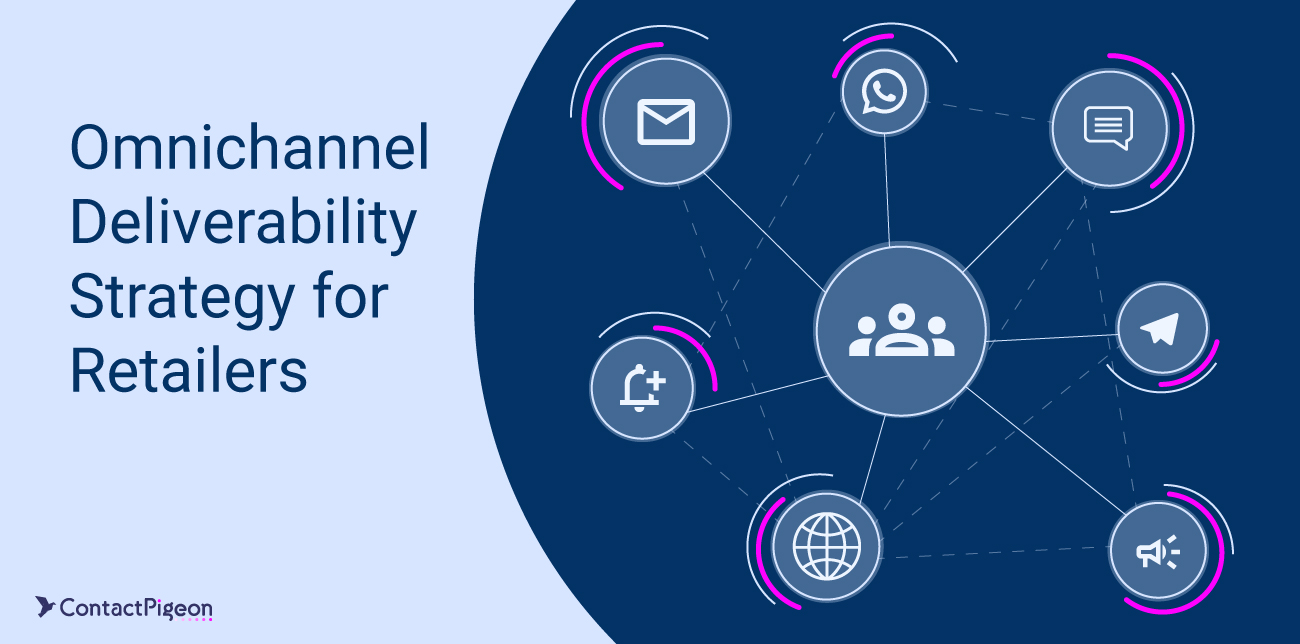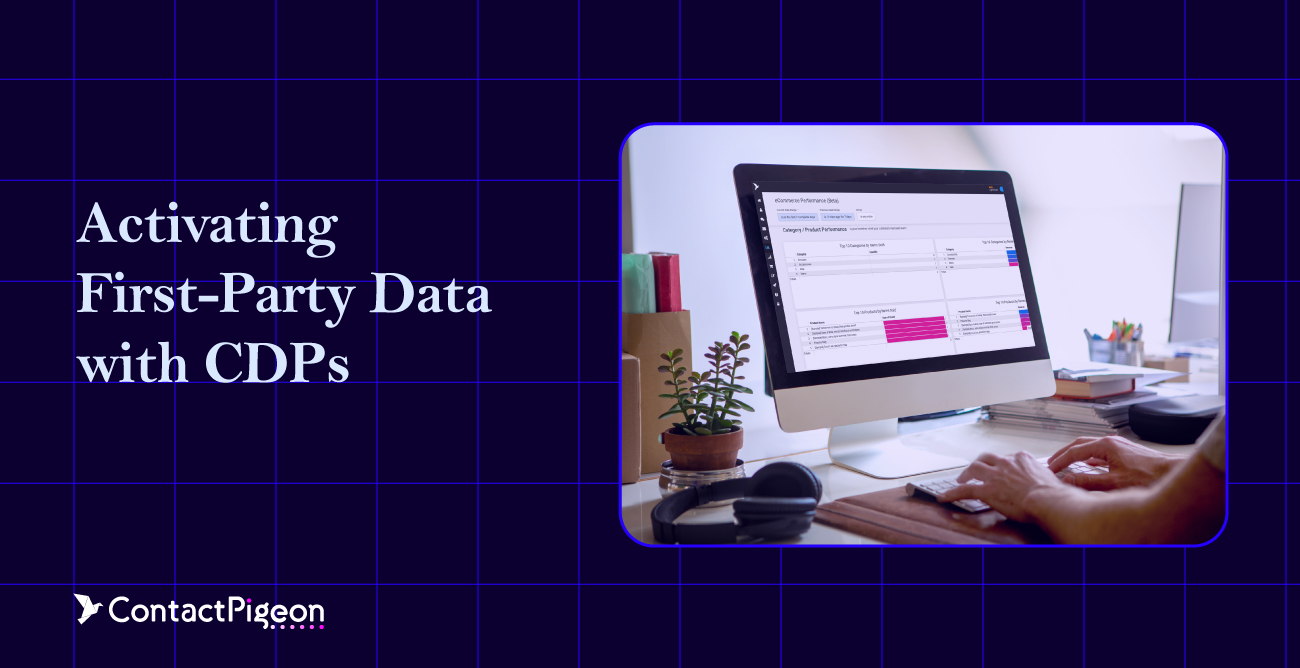Seamless communication is the backbone of modern retail success, and leveraging a robust omnichannel deliverability strategy is essential for staying ahead. Channels like Email, SMS, Viber, WhatsApp, and Push notifications are the linchpins of a successful strategy, ensuring your messages reach customers precisely when and where they are most receptive. This guide delves into best practices for optimizing these communication channels, empowering your retail brand to maximize customer satisfaction and drive sustained growth. Discover the strategic insights needed to refine your approach and outperform the competition.
What is omnichannel deliverability in retail marketing?
Omnichannel deliverability in retail marketing refers to the strategic integration and optimization of multiple communication channels—Email, SMS, Viber, WhatsApp, and Push notifications. This approach ensures that marketing messages reach customers efficiently and effectively, regardless of the platform they prefer. By delivering consistent and personalized experiences across these varied touchpoints, retailers can enhance customer engagement, improve satisfaction, and drive higher conversion rates. The goal is to create a seamless and cohesive interaction with the customer, making every touchpoint an opportunity to reinforce the brand and build loyalty.
Benefits of a robust communication deliverability strategy
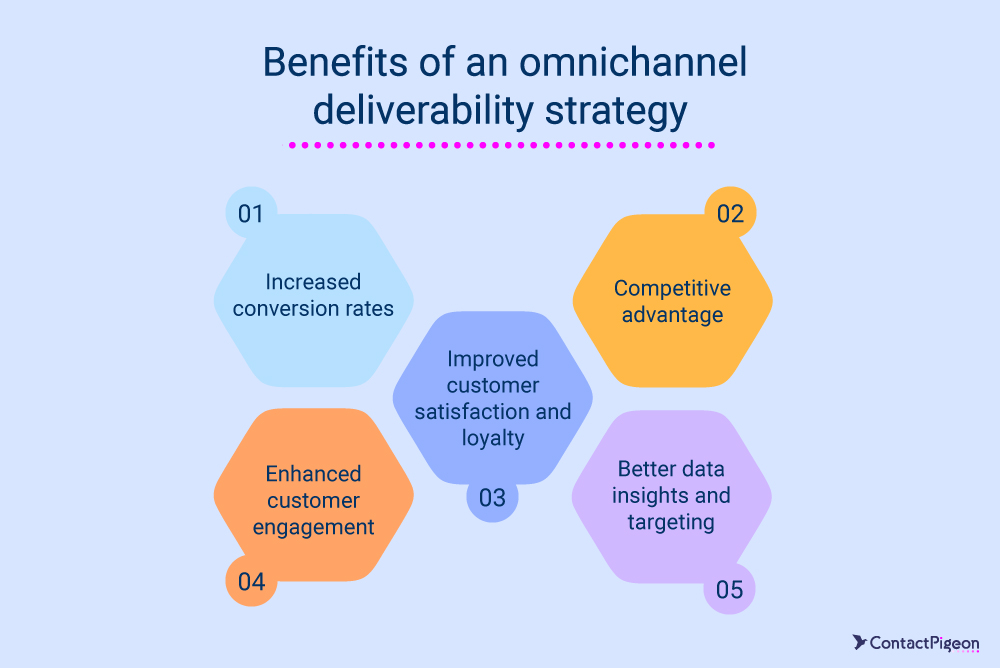
- Enhanced customer engagement: By effectively utilizing channels such as Email, SMS, Viber, WhatsApp, and Push notifications, retailers can reach customers on their preferred platforms, fostering higher engagement rates. Personalized and timely messages ensure that customers feel valued and understood, leading to more meaningful interactions.
- Increased conversion rates: A well-executed omnichannel deliverability strategy ensures that marketing messages are not only received but also acted upon. By delivering relevant content at the right time and place, retailers can drive higher conversion rates, turning potential leads into loyal customers.
- Improved customer satisfaction and loyalty: Consistent and personalized communication across multiple channels enhances the overall customer experience. When customers receive timely and relevant information, their satisfaction increases, which in turn builds trust and loyalty to the brand.
- Better data insights and targeting: Integrating various communication channels allows retailers to gather comprehensive data on customer behaviors and preferences. This wealth of information can be analyzed to refine targeting strategies, ensuring that future messages are even more relevant and impactful.
- Competitive advantage: In a crowded marketplace, a robust communication deliverability strategy sets retailers apart from their competitors. By leveraging the full potential of omnichannel marketing, retailers can stay ahead of the curve, adapting quickly to changing customer needs and market trends. This proactive approach not only attracts new customers but also retains existing ones, ensuring long-term success.
Components of an effective omnichannel deliverability strategy
- Build high-quality lists: Focus on collecting genuine and interested subscribers through various channels such as website sign-ups, social media promotions, and in-store prompts. Obtain explicit consent from customers to ensure compliance with privacy regulations.
- Ensure compliance with regulations: Adhere to regulations such as TCPA (Telephone Consumer Protection Act) and GDPR to maintain legal compliance and build trust with your audience.
- Segment your audience: Divide your list into smaller, targeted segments based on demographics, behavior, preferences, and engagement levels. This helps in sending more relevant and personalized content, improving overall engagement and deliverability.
- Engage inactive subscribers: Run re-engagement campaigns for subscribers who have not interacted recently, or remove them if they remain unresponsive.
- Implement double opt-in: Use a double opt-in process to confirm subscribers’ interest and ensure the accuracy of email addresses, reducing the likelihood of spam complaints and hard bounces.
- Personalized communication: Use personalized content, such as addressing subscribers by their name and tailoring messages based on their preferences and behaviors. This enhances engagement and makes messages more relevant and engaging.
- Regularly clean your lists: Periodically remove inactive subscribers and invalid contact information to maintain a healthy list and improve deliverability rates. This applies to email, SMS, and other messaging platforms.
- Monitor and analyze performance: Track key metrics such as delivery rates, open rates, click-through rates, and engagement levels. Regularly analyze this data to identify and resolve any issues promptly, ensuring continuous improvement in deliverability.
- A/B Testing: Conduct A/B testing on different elements like message content, send times, and call-to-actions. Determine what works best for your audience to optimize engagement and deliverability across all channels.
Email deliverability optimization
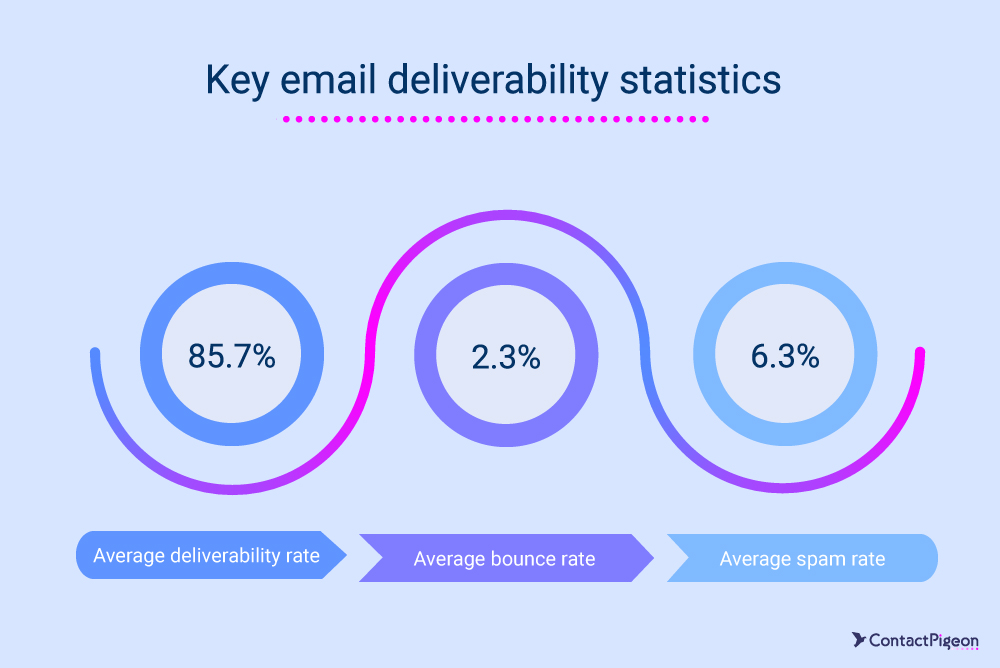
Why it matters:
- The average email deliverability rate is 85.7%, with a bounce rate of 2.3% and a spam rate of 6.3%. (Sender)
- 63% of businesses modify the frequency of their email sends according to subscriber engagement levels. (Mailmodo)
- To ensure email bounce rates remain within acceptable limits, aim to keep them below 3%. (Mailmodo)
What it includes:
- Authenticate your emails: Implement authentication protocols like DKIM, SPF, and DMARC to verify your emails’ legitimacy and prevent them from being flagged as spam.
- Optimize email content and design: Ensure that your email content is engaging, relevant, and mobile-friendly, with a clear call-to-action, to improve open and click-through rates.
- Monitor and analyze deliverability metrics: Regularly track metrics such as bounce rates, spam complaints, and inbox placement rates to identify and resolve deliverability issues promptly.
- Maintain a consistent sending schedule: Establish a regular email sending schedule to keep your audience engaged without overwhelming them, which helps maintain a positive sender reputation.
- Test emails before sending: Conduct A/B testing on different email elements (subject lines, content, design) to determine what works best for your audience and improves deliverability.
- Use a reputable email service provider: Choose an email service provider with a strong reputation for deliverability and comprehensive support features.
- Avoid spam triggers: Be mindful of words, phrases, and formatting that could trigger spam filters, and ensure your emails are compliant with best practices.
Expected input time needed: 4-6 weeks
Departments needed: Analytics, Marketing, IT
How often to conduct: Once or twice per fiscal year

SMS deliverability optimization
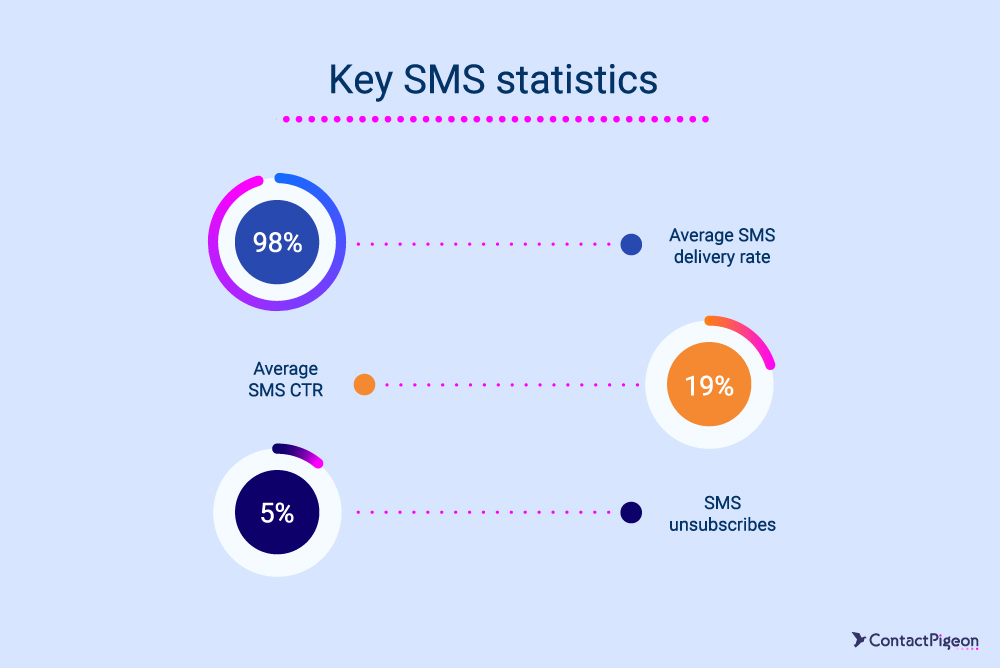
Why it matters:
- The average SMS open rate is 98%, with a click-through rate of 19% and less than 5% unsubscribing. (Luisazhou)
- 90% of customers have found SMS loyalty programs valuable. (Luisazhou)
- 91% of consumers want to receive text messages from businesses. (Luisazhou)
What it includes:
- Use clear and concise messaging: Craft messages that are brief, clear, and to the point, ensuring that the value and call-to-action are immediately apparent.
- Optimize send times: Schedule SMS messages to be sent at optimal times based on your audience’s behavior and time zones to maximize engagement.
- Test different variables: Conduct A/B testing on various elements like message content, send times, and call-to-actions to determine what resonates best with your audience.
- Ensure technical infrastructure: Work with reliable SMS gateway providers and ensure your technical infrastructure is robust enough to handle message delivery efficiently.
- Monitor carrier compliance: Stay updated with carrier guidelines and restrictions to avoid having messages blocked or flagged as spam.
- Use shortcodes and keywords: Implement shortcodes and keywords for easy opt-in and interaction, making it simple for customers to subscribe and engage.
- Optimize redirection pages: Ensure that any links in your SMS messages lead to mobile-friendly landing pages to provide a seamless user experience.
Expected input time needed: 2-4 weeks
Departments needed: Marketing, IT, customer service
How often to conduct: Quarterly
Viber and WhatsApp deliverability optimization

Why it matters:
- For businesses, WhatsApp has a base open rate of 58% and a conversion rate ranging from 45-60%. (Doubletick)
- Viber boasts a delivery rate of 97% and an average click-through rate of 82%. (99firms)
- 40% of Viber’s revenue is generated through its Business API. (99firms)
- WhatsApp chatbots can dramatically boost lead generation, achieving over a 5X increase. (Doubletick)
What it includes:
- Ensure compliance with platform policies: Familiarize yourself with and adhere to Viber and WhatsApp’s policies to avoid penalties and ensure smooth message delivery.
- Use rich media and interactive content: Leverage the multimedia capabilities of Viber and WhatsApp by incorporating images, videos, and interactive elements to make messages more engaging.
- Optimize message timing: Analyze customer behavior to determine the best times to send messages, maximizing open and engagement rates.
- Implement automated workflows: Use automation tools to send timely and contextually relevant messages based on customer actions and triggers.
- Use business profiles and verified accounts: Set up official business profiles and get verified to enhance credibility and trust, which can improve message delivery rates.
- Engage with customers in real-time: Use the chat functionality of Viber and WhatsApp to provide instant support and engage with customers in real-time, boosting satisfaction and loyalty.
- Optimize links and landing pages: Ensure that any links in your messages lead to mobile-optimized landing pages to provide a seamless user experience.
- Stay updated with platform changes: Regularly review updates and changes to Viber and WhatsApp’s features and policies to adapt your strategy accordingly.
Expected input time needed: 3-5 weeks
Departments needed: Analytics, Marketing, IT, Customer Service
How often to conduct: Once or twice per fiscal year
Push notifications deliverability optimization
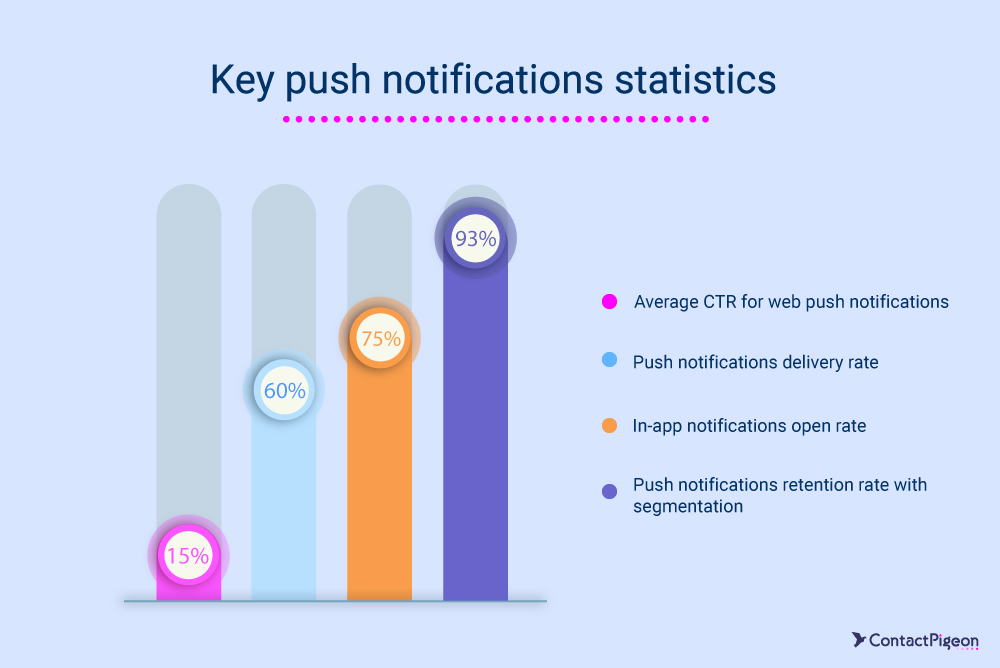
Why it matters:
- Push notifications have a delivery rate of 90% and a 93% retention rate with segmentation. (Truelist)
- The average click-through rate for web push notifications is 15%, and in-app notifications have a 75% open rate. (Truelist)
- The overall opt-in rate for push notifications is 60%. (businessofapps)
- Only 0.1% of recipients unsubscribe shortly after receiving the first notification. (notifyvisitors)
What it includes:
- Optimize messages: Craft concise, compelling messages with clear calls-to-action to increase engagement and click-through rates.
- Timing and frequency: Analyze user behavior to determine optimal times for sending notifications and avoid overloading users with too many messages.
- Use rich media: Incorporate images, videos, and interactive elements to make notifications more engaging and visually appealing.
- Monitor delivery rates and engagement: Track metrics such as delivery rates, open rates, and click-through rates to identify and address any issues with notification delivery.
- Optimize for different platforms: Ensure notifications are optimized for both iOS and Android devices, considering the specific guidelines and best practices for each platform.
- Leverage geolocation: Use geolocation data to send relevant notifications based on the user’s location, enhancing the personalization and relevance of messages.
- Compliance with best practices: Ensure your push notification practices comply with privacy regulations and best practices to maintain user trust and avoid legal issues.
- Analyze and refine strategies: Regularly analyze the performance of your push notifications and refine your strategy based on data-driven insights to improve deliverability and engagement.
Expected input time needed: 2-3 weeks
Departments needed: Marketing, IT, analytics, customer service
How often to conduct: Quarterly
Additional components to consider
Multi-channel integration
- Ensure consistency across email, SMS, push notifications, social media, and direct mail.
- Leverage omnichannel platforms like ContactPigeon to synchronize messaging and touchpoints.
Feedback loops and continuous improvement
- Establish feedback mechanisms to gather customer input on communication preferences and satisfaction.
- Continuously iterate and improve based on feedback and performance data.
Technical infrastructure
- Maintain a robust technical infrastructure to support high-volume, high-frequency communications.
- Ensure proper DNS settings, SPF, DKIM, and DMARC configurations to enhance email deliverability.
Testing and quality assurance
- Implement quality assurance processes to ensure error-free and professional communications.
A 360-degree omnichannel deliverability checklist for eCommerce retailers
| Channel | Checklist Item | Details |
|---|---|---|
| Pre-Send Checklist |
|
|
| Content and Design |
|
|
| Sending Practices |
|
|
| Post-Send Analysis |
|
|
| Push Notifications | Pre-Send Checklist |
|
| Push Notifications | Content and Design |
|
| Push Notifications | Sending Practices |
|
| Push Notifications | Post-Send Analysis |
|
| Viber | Pre-Send Checklist |
|
| Viber | Content and Design |
|
| Viber | Sending Practices |
|
| Viber | Post-Send Analysis |
|
| SMS | Pre-Send Checklist |
|
| SMS | Content and Design |
|
| SMS | Sending Practices |
|
| SMS | Post-Send Analysis |
|
Future trends that will shape omnichannel deliverability in retail marketing
By staying ahead of these trends, retail executives can ensure their communication strategies remain effective and relevant in an evolving digital landscape.
- AI-powered personalization and predictive analytics: AI and machine learning will drive hyper-personalized communication strategies, predicting customer behavior and tailoring messages to individual preferences and needs.
- Omnichannel integration and consistency: Seamless integration across multiple channels (email, SMS, social media, etc.) will be crucial for consistent messaging and enhanced customer experience (CX).
- Enhanced data privacy and compliance measures: Stricter data privacy regulations (GDPR, CCPA) will require advanced compliance strategies to maintain deliverability and customer trust.
- Voice and conversational commerce: The rise of voice assistants and chatbots will transform communication deliverability, providing real-time, conversational engagement with customers.
- Blockchain for email authentication and security: Blockchain technology will enhance email authentication, ensuring message integrity and reducing the risk of spam and phishing attacks.
- Increased adoption of AMP for email: Accelerated Mobile Pages (AMP) in emails will provide interactive and dynamic content, improving engagement rates and deliverability.
- Real-time analytics and responsive campaigns: Real-time analytics will enable responsive and adaptive marketing campaigns, optimizing communication strategies based on immediate feedback and data.
- Focus on zero-party data collection: Retailers will prioritize zero-party data (information customers willingly share) to enhance personalization and improve deliverability by building trust and transparency.
- Advancements in Natural Language Processing (NLP): NLP will refine message tone and context, enabling more natural and effective communication with customers, boosting engagement and deliverability.
- Sustainability and ethical marketing practices: Emphasizing sustainability and ethical marketing will become vital, with customers expecting transparency and responsibility in communication, positively impacting deliverability.
Things to consider during the deliverability strategy design process
By integrating these key learnings into the design process, retail executives can create a robust and effective communication deliverability strategy that not only reaches customers but also engages and retains them through personalized, secure, and ethical practices.
- Leverage multiple channels: Use Email, SMS, Viber, WhatsApp, and Push notifications to reach customers effectively.
- Consistency across channels: Ensure consistent and personalized messages across all touchpoints.
- Personalized communication: Tailor messages to individual preferences and behaviors.
- Optimal timing: Send messages at times when customers are most receptive.
- Segmentation: Divide audiences into targeted segments for more relevant content delivery.
- Data integration: Collect and analyze data from various channels for better targeting and insights.
- Regulatory compliance: Adhere to GDPR, TCPA, and other regulations to build trust and avoid legal issues.
- Engage inactive subscribers: Run re-engagement campaigns or remove unresponsive contacts to maintain a healthy list.
- Content optimization: Ensure messages are engaging, mobile-friendly, and free from spam triggers.
- Use real-time analytics: Continuously monitor and refine strategies based on real-time performance data.
Discover more omnichannel resources for retailers
- The 55 Best Omnichannel Statistics for Retailers
- Omnichannel Retail: All You Need to Know for 2024
- 20 Top eCommerce Trends to Watch in 2024
- The 12 Key Omnichannel Retail Trends of 2024
- What Is a Customer Data Platform, and Why Does a Retailer Need One?
ContactPigeon can assist retailers develop a highly effective omnichannel deliverability strategy
ContactPigeon’s Customer Data Platform (CDP) empowers retailers to develop effective omnichannel deliverability strategies by providing a unified and holistic view of each customer. By integrating data from various sources, the platform ensures real-time data synchronization for accurate and timely customer insights.
The advanced segmentation capabilities of ContactPigeon’s CDP enable retailers to create dynamic segments based on behavior, demographics, and purchase patterns, allowing for hyper-personalized campaigns. This level of personalization significantly enhances engagement and conversion rates. Additionally, ContactPigeon supports a wide range of communication channels, ensuring consistent messaging across email, SMS/Viber/WhatsApp, push notifications, social media, and more. This omnichannel integration provides a seamless customer experience.
Robust analytics tools within the platform offer real-time insights into customer interactions and campaign performance, facilitating data-driven decision-making and continuous optimization. Emphasizing data privacy and compliance, ContactPigeon helps retailers navigate regulations such as GDPR and CCPA, maintaining customer trust and improving deliverability.
Transform your retail marketing strategy with ContactPigeon’s CDP. Book a demo today to see how our platform can elevate your omnichannel deliverability.

Let’s Help You Scale Up


